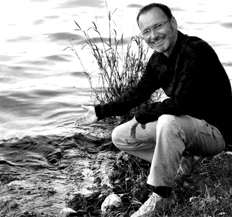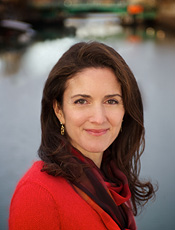Related Research Articles

Landscape architecture is the design of outdoor areas, landmarks, and structures to achieve environmental, social-behavioural, or aesthetic outcomes. It involves the systematic design and general engineering of various structures for construction and human use, investigation of existing social, ecological, and soil conditions and processes in the landscape, and the design of other interventions that will produce desired outcomes.

A landscape architect is a person who is educated in the field of landscape architecture. The practice of landscape architecture includes: site analysis, site inventory, site planning, land planning, planting design, grading, storm water management, sustainable design, construction specification, and ensuring that all plans meet the current building codes and local and federal ordinances.

Richard Haag was an American landscape architect who was known for his role in Gas Works Park in Seattle, Washington and on the Bloedel Reserve on Bainbridge Island. Richard Haag's modernist and minimalist ideals also set the tone for Northwestern landscape design.

Peter Walker is an American landscape architect and the founder of PWP Landscape Architecture.

Laurie Olin is an American landscape architect. He has worked on landscape design projects at diverse scales, from private residential gardens to public parks and corporate/museum campus plans.
Michael Robert Van Valkenburgh is an American landscape architect and educator. He has worked on a wide variety of projects in the United States, Canada, Korea, and France, including public parks, college campuses, sculpture gardens, city courtyards, corporate landscapes, private gardens, and urban master plans.
Landscape urbanism is a theory of urban design arguing that the city is constructed of interconnected and ecologically rich horizontal field conditions, rather than the arrangement of objects and buildings. Landscape Urbanism, like Infrastructural Urbanism and Ecological Urbanism, emphasizes performance over pure aesthetics and utilizes systems-based thinking and design strategies. The phrase 'landscape urbanism' first appeared in the mid 1990s. Since this time, the phrase 'landscape urbanism' has taken on many different uses, but is most often cited as a postmodernist or post-postmodernist response to the "failings" of New Urbanism and the shift away from the comprehensive visions, and demands, for modern architecture and urban planning.
Grant Richard Jones is an American landscape architect, poet, and founding principal of the Seattle firm Jones & Jones Architects, Landscape Architects and Planners. In more than four decades of practice, his work in ecological design has garnered widespread recognition for its broad-based and singular approach, one that is centered on giving voice to the land and its communities. Called the “poet laureate of landscape architecture” Jones's poetry informs his designs.

The Olympic Sculpture Park, created and operated by the Seattle Art Museum (SAM), is a public park with modern and contemporary sculpture in downtown Seattle, Washington, United States. The park, which opened January 20, 2007, consists of a 9-acre (36,000 m2) outdoor sculpture museum, an indoor pavilion, and a beach on Puget Sound. It is situated in Belltown at the northern end of the Central Waterfront and the southern end of Myrtle Edwards Park.

Herbert Dreiseitl is a sculptor, artist, landscape architect and interdisciplinary urban planner. He founded the firm Atelier Dreiseitl in 1980 with a vision to develop liveable cities inspired by a deep understanding of water. In 2013, the studio was acquired by the Danish-based international consultancy group and continued under the name Ramboll Studio Dreiseitl. As of 2023, Dreiseitl's office is located in Überlingen, Germany, still a local affiliate of Ramboll. He has taught courses at the National University of Singapore and at Harvard University.

Walter J. Hood, is an American designer, artist, academic administrator, and educator. He is the former chair of landscape architecture at the University of California, Berkeley, and principal of Hood Design Studio in Oakland, California. Hood has worked in a variety of settings including architecture, landscape architecture, visual art, community leadership, urban design, and in planning and research. He has spent more than 20 years living in Oakland, California. He draws on his strong connection to the Black community in his work. He has chosen to work almost exclusively in the public realm and urban environments.

Kongjian Yu, is a landscape architect and urbanist, writer and educator, commonly credited with the invention of Sponge City concept, and winner of the International Federation of Landscape Architects’ Sir Geoffrey Jellicoe Award in 2020. Received his Doctor of Design Degree from Harvard Graduate School of Design in 1995, Doctor Honoris Causa from Sapienza University of Rome in 2017 and Honorary Doctorate from Norwegian University of Life Sciences in 2019, Yu was elected to the American Academy of Arts and Sciences in 2016.
EDSA, Inc.,, is an American firm specializing in planning, landscape architecture, and urban design. EDSA employs over 150 individuals from more than 25 countries, and it reports having completed over 500 projects in over 100 countries.
Andrea Cochran is an American landscape architect based in San Francisco. She is a fellow of the American Society of Landscape Architects and one of seven designer women featured in the 2012 documentary Women in the Dirt.

Cheryl Barton is an American landscape architect and founding principal of the San Francisco-based Office of Cheryl Barton. A Fellow and Past President of the American Society of Landscape Architects, she has completed a wide range of national and international projects in the US, Europe, Singapore, Abu Dhabi, and Bolivia. Her work includes national and local public parks, urban open spaces and master plans, cultural landscapes, college and institutional campuses, public art installations, corporate landscapes, and ecological master plans. Barton has received an Individual Fellowship from the National Endowment for the Arts and the Rome Prize in Landscape Architecture from the American Academy in Rome. She was featured in the 2012 documentary, Women in the Dirt.
EDAW was an international landscape architecture, urban and environmental design firm that operated from 1939 until 2009. Starting in San Francisco, United States, the company at its peak had 32 offices worldwide. EDAW led many landscape architecture, land planning and master planning projects, developing a reputation as an early innovator in sustainable urban development and multidisciplinary design.

W Architecture & Landscape Architecture is an international architecture and landscape architecture firm based in Brooklyn, New York City. Founded in 1999 by Barbara E. Wilks, the firm is primarily known for its design of major waterfront reclamation projects and collaborative repurposing of public spaces. W Architecture has received substantial coverage in the media for the Edge Park in Williamsburg, Brooklyn; a redesign of the West Harlem waterfront; restoration of St. Patrick's Island in Calgary; and the recent Plaza 33 Madison Square Garden adjacency.
Edmund David Hollander is an American landscape architect and educator. A New York City native, he is the president of Hollander Design Landscape Architects, a New York-based firm known for environmental planning, landscape design and horticulture. The firm provides services to residential, commercial and civic clients.

Susannah Drake is a practicing architect and landscape architect who specializes in addressing contemporary social and environmental issues through design.
Shannon Nichol is an American landscape architect and founding principal of Gustafson Guthrie Nichol (GGN), located in Seattle. Nichol has led many of GGN's landscape design projects, including the designs for Boston's North End Parks, Seattle's Bill & Melinda Gates Foundation campus, and San Francisco's India Basin Shoreline. In 2018, she was elected a member of the National Academy of Design in the category "Architecture."
References
- ↑ "Anchorage Museum Common :: Charles Anderson". Ca-atelierps.com. 2008-04-25. Archived from the original on 2013-12-03. Retrieved 2013-05-02.
- ↑ "Arthur Ross Terrace :: Charles Anderson". Ca-atelierps.com. Archived from the original on 2012-07-06. Retrieved 2013-05-02.
- ↑ "International Peace Gardens :: Charles Anderson". Ca-atelierps.com. 2008-04-17. Archived from the original on 2012-07-06. Retrieved 2013-05-02.
- 1 2 "World-Class Soccer Stadium Underway in Haiti". ArchDaily. 2 February 2013. Retrieved 2013-05-02.
- ↑ "Olympic Sculpture Park :: Charles Anderson". Ca-atelierps.com. 2007-02-07. Archived from the original on 2013-08-07. Retrieved 2013-05-02.
- ↑ "Trillium Projects :: Charles Anderson". Ca-atelierps.com. Archived from the original on 2012-07-06. Retrieved 2013-05-02.
- 1 2 "ASLA Fellows". asla.org. Retrieved 2013-05-02.
- ↑ "Biography". Nasher Sculpture Center. Archived from the original on 2010-11-27. Retrieved 2013-05-02.
- 1 2 DIRT Studio. "DIRT Studio". DIRT Studio. Retrieved 2013-05-02.
- ↑ Julie Bargmann, “Just Ground: a social infrastructure for urban landscape regeneration,” in Resilience in Urban Ecology and Design: Linking Theory and Practice for Sustainable Cities, ed. Steward Pickett, (New York: Springer), 2013.
- ↑ "Hellinikon, Athens Greece, with Foster + Partners, London". YouTube. Retrieved 2014-06-24.
- ↑ "World-Cass Soccer Stadium Underway in Haiti". ArchDaily. 2 February 2013. Retrieved 2013-05-02.
- ↑ "A proud partnership with Kumin Associates and David Chipperfield Architects". Official website. Anchorage Museum. Archived from the original on 6 July 2011. Retrieved 8 June 2011.
- ↑ "General Design Honor Award". ASLA.
- ↑ "Mount St. Helens National Volcanic Monument :: Charles Anderson". Ca-atelierps.com. Archived from the original on 2012-07-06. Retrieved 2013-05-02.
- ↑ "Roxhill Bog :: Charles Anderson". Ca-atelierps.com. Archived from the original on 2012-07-06. Retrieved 2013-05-02.
- ↑ "500 Area of Discovery Park :: Charles Anderson". Ca-atelierps.com. Archived from the original on 2012-07-06. Retrieved 2013-05-02.
- 1 2 "©". Asla.org. Retrieved 2013-05-02.
- ↑ "ASLA 2006 Professional Awards". Official website. ASLA. Retrieved 8 June 2011.
- ↑ "ASLA 2005 Professional Awards". Asla.org. Retrieved 2013-05-02.
- ↑ "2004 ASLA Professional Awards". Official website. ASLA. Retrieved 8 June 2011.
- ↑ "ASLA Announces 2008 Honors". asla.org. Retrieved 2013-05-02.
- ↑ "Class Search / Course Catalog".
- ↑ Ashton Nichols. Beyond Romantic Ecocriticism: Toward Urbanatural Roosting. New York, NY: Palgrave Macmillan, 2011. ISBN 978-1137033994
- ↑ "Our Mission". Project Phoenix. Archived from the original on 2013-05-17. Retrieved 2013-05-02.
- ↑ http://www.wasla.org/wp-content/uploads/2012/08/TheAnchorageMuseumCommon.pdf%5B%5D
- ↑ "Archived copy" (PDF). places.designobserver.com. Archived from the original (PDF) on 3 December 2013. Retrieved 22 May 2022.
{{cite web}}: CS1 maint: archived copy as title (link) - ↑ Luke, By. "T+L Design Awards 2008 – Articles | Travel + Leisure". Travelandleisure.com. Retrieved 2013-05-02.
- ↑ "Olympic Sculpture Park, Seattle Art Museum". World Buildings Directory. Archived from the original on 2014-12-17. Retrieved 2013-05-02.
- ↑ Julie Decker. Wandering Ecologies: The Landscape Architecture of Charles Anderson. Design Media Publishing Ltd, 2011. ISBN 978-9881973962